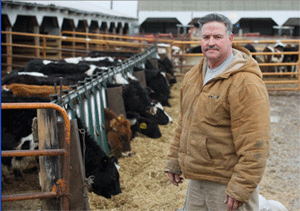Sustainable Agriculture; Feeding and Protecting the World
Author
Published
4/21/2010
 As we approach the 40th anniversary of Earth Day, a lot of Iowans who make their living tending the soils are honoring the progress and the challenges time has brought to agriculture. Global population has more than doubled since the days when my Great Grandfather used a horse to plow the soil of our Poweshiek County farm. Back then, his only task was to feed his family and community. Each farmer grew enough food to feed eight people. Now, my sons are now the sixth generation Langs to turn soil on our farm.
As we approach the 40th anniversary of Earth Day, a lot of Iowans who make their living tending the soils are honoring the progress and the challenges time has brought to agriculture. Global population has more than doubled since the days when my Great Grandfather used a horse to plow the soil of our Poweshiek County farm. Back then, his only task was to feed his family and community. Each farmer grew enough food to feed eight people. Now, my sons are now the sixth generation Langs to turn soil on our farm.
But today, being ‘sustainable’ means each farmer has to feed about 155 people. Just as our ‘community’ of Brooklyn has grown, (1355, according to the last Census); so has the world. Farmers like me share the respnsibility to feed, fuel and provide fiber for a growing world of 6.5-billion; one that will increase by another 1-billion in the next decade.
While countries such as China and India grow in numbers and wealth, so too, does their demand for grain-fed meat. Those same populations are also seeking out the use of crops for biofuels such as ethanol, biobutanol and soy diesel to reduce demand for costly foreign-oil based fuels and fertilizers.
In 2010, farmers remain ‘sustainable’ if they protect their priceless (and ever diminishing) acres of available, fertile farmland. Clearly, the argument of being ‘sustainable’ isn’t size or even commodity-specific; it’s about being better at what you do, with the resources you have available. It’s about embracing technology, not railing against it.
Technology brings better seed genetics, better equipment to farmers and new careers for our children (studying seed genomes, creating renewable energy sources, biochemistry, livestock odor control and more). But, taking that science from the lab to the field takes an ability to adapt and diversify. Successful farmers are doing that, and that is why the shelves at your grocery store or local Farmer’s Market are full of choices that, through the hard work of farmers, we are happy to provide.
In 1945, long before the first Earth Day, corn farmers grew an average of 33 bushels per acre. Today, thanks to these advances, I grow nearly 200 bushels on the same acre of land my Grandfather did. Many farmers have achieved yields much higher, even up to a record of 440 bushels per acre. For the sake of hungry people; we need to do even better.
As we celebrate Earth Day 2010, it’s true that technology is blurring the borders of our hometowns and helping all farmers meet demand for constantly-evolving consumer food choices. But, we must continue to be responsible in meeting that goal; good farmers are protecting the soil and the water from over-use or erosion by either planting grassy buffer strips to protect waterways, planting terraces to reduce erosion and leaving crop stubble on the ground year-round to hold soil and nutrients in place, (no-till farming).
These efforts weren’t done in my Great-Grandfather’s day. But now, combining what we know with what we grow is making a difference.
Written by Craig Lang